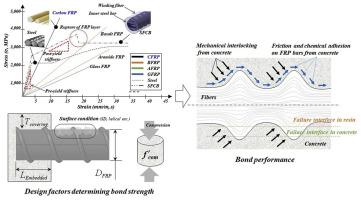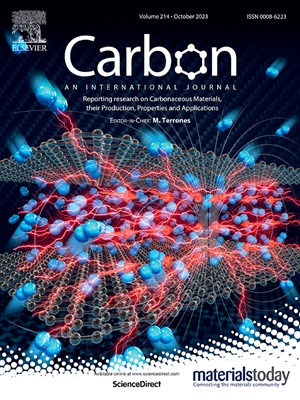Enhancing bond performance of carbon fiber reinforced plastic bars in concrete structures: Insights and guidelines
IF 10.5
2区 材料科学
Q1 CHEMISTRY, PHYSICAL
引用次数: 0
Abstract
This study examines the adhesion characteristics of fiber reinforced plastic (FRP) bars, specifically focusing on carbon fiber reinforced plastic (CFRP), within concrete matrices. Key findings underscore the significant influence of the concrete compressive strength values such as embedment length, surface treatment, and environmental conditions. Enhanced concrete compressive strength positively impacts interfacial strength, while longer embedment lengths result in weak interfaces within the composites. Surface treatment, particularly sand coating, is crucial when promoting higher interfacial bond strengths and adhesion. Comparisons with international design codes reveal discrepancies, with ACI 440.1R-15 closely matching test results. The study also highlights the advantages of using epoxy resins for FRP strengthening. In chloride environments, CFRP results in superior corrosion resistance when compared to basalt fiber reinforced polymer (BFRP) and glass fiber reinforced polymer (GFRP). However, interfacial bond strength retention decreases over prolonged exposure, exacerbated by wet-dry cycles and exposure to temperature fluctuations. Overall, this research provides valuable insights for selecting and designing robust concrete structures within FRP reinforcements, considering their advantages.

提高混凝土结构中碳纤维增强塑料条的粘结性能:启示与指南
本研究探讨了纤维增强塑料(FRP)棒材,特别是碳纤维增强塑料(CFRP)棒材在混凝土基体中的粘附特性。主要发现强调了混凝土抗压强度值(如嵌入长度、表面处理和环境条件)的重要影响。混凝土抗压强度的提高会对界面强度产生积极影响,而较长的预埋长度则会导致复合材料内部的界面变得脆弱。表面处理,尤其是砂涂层,对于提高界面粘结强度和粘附力至关重要。与国际设计规范的比较显示出差异,ACI 440.1R-15 与测试结果非常吻合。研究还强调了使用环氧树脂进行玻璃钢加固的优势。在氯化物环境中,与玄武岩纤维增强聚合物(BFRP)和玻璃纤维增强聚合物(GFRP)相比,CFRP 具有更强的耐腐蚀性。然而,界面粘接强度保持率会随着长期暴露而降低,干湿循环和暴露于温度波动会加剧这种情况。总之,考虑到玻璃纤维增强聚合体的优势,这项研究为选择和设计使用玻璃纤维增强聚合体的坚固混凝土结构提供了有价值的见解。
本文章由计算机程序翻译,如有差异,请以英文原文为准。
求助全文
约1分钟内获得全文
求助全文
来源期刊

Carbon
工程技术-材料科学:综合
CiteScore
20.80
自引率
7.30%
发文量
0
审稿时长
23 days
期刊介绍:
The journal Carbon is an international multidisciplinary forum for communicating scientific advances in the field of carbon materials. It reports new findings related to the formation, structure, properties, behaviors, and technological applications of carbons. Carbons are a broad class of ordered or disordered solid phases composed primarily of elemental carbon, including but not limited to carbon black, carbon fibers and filaments, carbon nanotubes, diamond and diamond-like carbon, fullerenes, glassy carbon, graphite, graphene, graphene-oxide, porous carbons, pyrolytic carbon, and other sp2 and non-sp2 hybridized carbon systems. Carbon is the companion title to the open access journal Carbon Trends. Relevant application areas for carbon materials include biology and medicine, catalysis, electronic, optoelectronic, spintronic, high-frequency, and photonic devices, energy storage and conversion systems, environmental applications and water treatment, smart materials and systems, and structural and thermal applications.
 求助内容:
求助内容: 应助结果提醒方式:
应助结果提醒方式:


